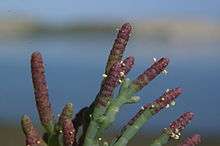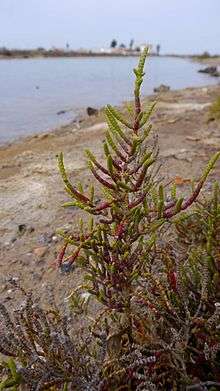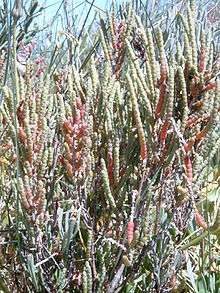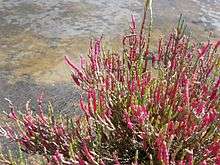Sarcocornia
Sarcocornia is a genus of flowering plants in the amaranth family, Amaranthaceae. They are known commonly as samphires, glassworts, or saltworts.[1] The genus has a cosmopolitan distribution,[2] and is most diverse in the Cape Floristic Region of South Africa.[3]
| Sarcocornia | |
|---|---|
| Sarcocornia quinqueflora | |
| Scientific classification | |
| Kingdom: | |
| (unranked): | |
| (unranked): | |
| (unranked): | Core eudicots |
| Order: | |
| Family: | |
| Subfamily: | |
| Genus: | Sarcocornia A.J.Scott |
| Species | |
|
ca. 30 species, see text | |
Description
The species of Sarcocornia are perennial herbs, subshrubs or shrubs.[4] They are taking an erect or prostrate, creeping form.[5] The new stems are fleshy and divided into joint-like segments. Older stems are woody and not segmented. The oppositely arranged leaves are borne on fleshy, knobby petioles, their base decurrent and connate (thus forming the segments), the blades forming small, triangular tips with narrow scarious margin.[1]

The terminal or lateral inflorescences are spike-like, made up of joint-like segments with tiny paired cymes emerging from the joints. Each cyme consists of three (rarely five) flowers completely embedded between the bract and immersed in the fleshy tissue of the axis. The flowers of a cyme are arranged in a transverse row, the central flower separating the lateral flowers, with tissue of the axis between them. The hermaphrodite or unisexual flowers are more or less radially symmetric, with a perianth of three or four fleshy tepals connate nearly to the apex, one or two stamens, and an ovary with two or three stigmas.[1]
The perianth is persistent in fruit. The fruit wall (pericarp) is membranous. The vertical seed is ellipsoid, with light brown, membranous, hairy seed coat, the hairs can be strongly curved, hooked, or conic, straight or slightly curved. The seed contains no perisperm (feeding tissue).[1]
The basic chromosome number is x=9. The species are diploid (18 chromosomes), tetraploid (36), hexaploid (54), or octoploid (72).[4]
Distribution and habitat
Sarcocornia is distributed worldwide, especially in warm-temperate regions with mediterranean climate, and to some extent in the subtropics. The distribution area covers North and South America, Europe (Mediterranean basin and Atlantic coasts with mild winters), southern Africa, and Australia.[4]
These halophytic plants often occur in wet saline habitat types, and occasionally in dry saline soils. They can be found in habitats such as estuaries, salt marshes, tidal flats, seacliffs, salt pans, and saline sediment in seasonal desert waterways.[3] An exception is Sarcocornia xerophila, growing in semidesert on quartz soils with low salinity.[4]
Phylogenetics
Sarcocornia/Salicornia began to evolve during the Mid Miocene from ancestors in Eurasia, developing four phylogenetic lineages: the first was the Eurasian Sarcocornia clade, further diversifying into the American Sarcocornia clade, then the Salicornia clade, and the South African/Australian Sarcocornia clade. As Salicornia (comprising all annual, more frost tolerant species) has evolved within Sarcocornia, the genus Sarcocornia is paraphyletic.[4]
The prostrate, mat-forming growth seems to have evolved several times independently. It is probably advantageous in habitats with prolonged flooding, high tidal movement and frost.[4]
Systematics


The genus Sarcocornia was first described in 1978 by A J Scott,[6] thus separating the perennial species from the closely related annual Salicornia, additionally containing some species formerly belonging to Arthrocnemum. The type species is Sarcocornia perennis.[7]
The taxonomy of the genus has long been unclear. Study of the plants themselves is difficult because only fresh specimens can be used in the clear differentiation of taxa; many useful characters are not present in dry herbarium specimens.[1] Many sources accept the genus, but some authors continue to question its validity.[5] Molecular genetic studies revealed, that Sarcocornia/Salicornia form a monophyletic group, and Sarcocornia is paraphyletic.[4]
There are between 25 and 30 species in the genus,[4][8][9] forming three clades.[4] The center of diversity lies in southern Africa (Cape Floristic Region).[3][4]
- Eurasian Sarcocornia clade:[4] Until 2009, just Sarcocornia fruticosa and Sarcocornia perennis were known here,[10] since then, six new species have been described:
- Sarcocornia alpini (Lag.) Rivas-Martınez - on the Iberian peninsula
- Sarcocornia carinata (Fuente, Rufo & Sánchez Mata) Fuente, Rufo & Sánchez Mata - described from Spain[8]
- Sarcocornia fruticosa (L.) A.J.Scott - coasts of the Mediterranean Sea and Atlantic (France)
- Sarcocornia hispanica Fuente, Rufo & Sánchez-Mata - southeastern Iberian peninsula
- Sarcocornia lagascae Fuente, Rufo & Sánchez Mata - mediterranean coasts of the Iberian peninsula[8]
- Sarcocornia obclavata Yaprak - described from Turkey[9]
- Sarcocornia perennis (Miller) A.J.Scott – chickenclaws, perennial glasswort. Occurring at Atlantic and Mediterranean coasts in West and South Europe and North Africa.
- Sarcocornia pruinosa Fuente, Rufo & Sánchez-Mata - Atlantic coasts of France, Spain, and Portugal.
- American Sarcocornia clade:[4]
- Sarcocornia ambigua (Michx.) M.A.Alonso & M.B.Crespo - Atlantic coasts of North America, Caribic coasts
- Sarcocornia andina (Phil.) Freitag, M.A.Alonso & M.B.Crespo - endemic to the Atacama desert (Chile)
- Sarcocornia magellanica (Phil.) M.A.Alonso & M.B.Crespo - in Patagonia and Tierra del Fuego (Argentina)
- Sarcocornia neei (Lag.) M.A.Alonso & M.B.Crespo - Pacific coasts from Chile to Peru, northern part of Argentina to the Atlantic coast.
- Sarcocornia pacifica (Standl.) A.J.Scott – Pacific swampfire, Pacific glasswort. Occurring on Pacific coasts of North America from Alaska to Baja California, inland in southern California and Death Valley.
- Sarcocornia pulvinata (R.E.Fr.) A.J.Scott - Altiplano Andino in Peru and Bolivia
- Sarcocornia utahensis (Tidestr.) A.J.Scott – Utah swampfire. Distributed from Utah to Texas and northern Mexico, coasts of the Gulf of Mexico from northeastern Mexico to Louisiana, with an isolate occurrence at Bahamas (Panamint Lakes).
- South African/Australian Sarcocornia clade:[4]
- Sarcocornia blackiana (Ulbr.) A.J.Scott – thick-head glasswort. At coasts of southern and western Australia, Tasmania, coasts and inland of New Zealand and New Caledonia.
- Sarcocornia capensis (Moss) A.J.Scott - western and eastern Cape of South Africa.
- Sarcocornia decumbens (Tölken) A.J.Scott - southern and eastern Cape of South Africa and Mozambique
- Sarcocornia decussata S.Steffen, Mucina & G.Kadereit - western Cape of South Africa.
- Sarcocornia dunensis (Moss) S.Steffen, Mucina & G.Kadereit - endemic to Lüderitz, Namibia
- Sarcocornia freitagii S. Steffen, Mucina & G.Kadereit - western coast of South Africa
- Sarcocornia globosa P.G. Wilson - Western Australia
- Sarcocornia littorea (Moss) A.J.Scott - western and southern coast of South Africa
- Sarcocornia mossambicensis Brenan - southern Mozambique
- Sarcocornia mossiana (Tölken) A.J.Scott - western coast of South Africa
- Sarcocornia natalensis (Bunge ex Ung.-Sternb.) A.J.Scott - coasts of Atlantic and Indian Ocean of Namibia, South Africa, and Mozambique
- Sarcocornia pillansii (Moss) A.J.Scott - South African coasts
- Sarcocornia quinqueflora (Bunge ex Ung.-Sternb.) A.J. Scott – Australian samphire. At coasts of eastern, southern and western Australia, Tasmania, coasts and inland of New Zealand and New Caledonia.
- Sarcocornia tegetaria S.Steffen, Mucina & G.Kadereit - coasts of Atlantic and Indian Ocean of Namibia, South Africa, and Mozambique
- Sarcocornia terminalis (Tölken) A.J.Scott - endemic to Namaqualand in South Africa. The systematic position of this taxon is unclear.
- Sarcocornia xerophila (Tölken) A.J.Scott - endemic to Namaqualand in South Africa
References
- Ball, Peter W. (2004). "Sarcocornia." in Flora of North America: North of Mexico Volume 4: Magnoliophyta: Caryophyllidae, part 1, Editorial Committee of the Flora of North America (Oxford University Press, 2004). ISBN 978-0-19-517389-5..
- Sarcocornia. PlantNET. National Herbarium of New South Wales, Royal Botanic Garden, Sydney.
- Steffen, S.; et al. (2010). "Revision of Sarcocornia (Chenopodiaceae) in South Africa, Namibia and Mozambique". Systematic Botany. 35 (2): 390–408. doi:10.1600/036364410791638379.
- Steffen, S; Ball, P.; Mucina, L.; Kadereit, G. (2015). "Phylogeny, biogeography and ecological diversification of Sarcocornia (Salicornioideae, Amaranthaceae)". Annals of Botany. 115 (3): 353–368. doi:10.1093/aob/mcu260. PMC 4332613. PMID 25617410.
- Alonso, M. Á.; Crespo, M. B. (2008). "Taxonomic and nomenclatural notes on South American taxa of Sarcocornia (Chenopodiaceae)" (PDF). Annales Botanici Fennici. 45 (4): 241–254. doi:10.5735/085.045.0401.
- Scott, A.J. (1978). "Reinstatement and revision of Salicorniaceae J. Agardh (Caryophyllales)". Botanical Journal of the Linnean Society. 75 (4): 366–367. doi:10.1111/j.1095-8339.1977.tb01493.x.
- "Sarcocornia". Tropicos. Missouri Botanical Garden. Retrieved 12 August 2016.
- Fuente, V. de la; Rufo, L.; Rodriguez, N.; Sánchez-Mata, D.; Franco, A.; Amils, R. (2016). "A study of Sarcocornia A.J. Scott (Chenopodiaceae) from Western Mediterranean Europe". Plant Biosystems. 150 (2): 353. doi:10.1080/11263504.2012.752414.
- Yaprak, A. E. (2012). "Sarcocornia obclavata (Amaranthaceae) a new species from Turkey" (PDF). Phytotaxa. 49: 55–60. doi:10.11646/phytotaxa.49.1.9.
- Piirainen, M. (2009). "Sarcocornia." In: P. Uotila, (ed.): Chenopodiaceae. In: Euro+Med Plantbase - the information resource for Euro-Mediterranean plant diversity.
External links


- Sarcocornia. Red List of South African Plants. South African National Biodiversity Institute (SANBI).

